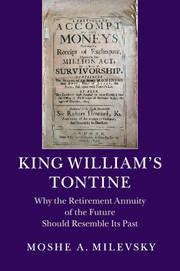Book contents
- Frontmatter
- Epigraph
- Contents
- Preface: In Memoriam for Jared
- Acknowledgments
- 1 King Billy, Protestant Hero of england
- 2 Tontine's Economic Origins: Cheaper Debt
- 3 A Most Curious Will(iam) and Older Than You Think
- 4 The Million Act to Fight a War against France
- 5 Don't Englishmen Die? Anti-Selection vs. Fraud
- 6 Is Your Tontine a Stock or a Bond?
- 7 Optimal Tontine: Hedging (Some) Longevity Risk
- 8 Conclusion: Tontines for the Twenty-First Century
- Epilogue: What Did William Really Know?
- Appendix A The List of Nominees
- Appendix B The Gompertz-Makeham Law of Mortality
- Appendix C 14% for One, 12% for Two, or 10% for Three?
- Source Notes and Guide to Further Reading
- References
- Index
Appendix C - 14% for One, 12% for Two, or 10% for Three?
Published online by Cambridge University Press: 05 May 2015
- Frontmatter
- Epigraph
- Contents
- Preface: In Memoriam for Jared
- Acknowledgments
- 1 King Billy, Protestant Hero of england
- 2 Tontine's Economic Origins: Cheaper Debt
- 3 A Most Curious Will(iam) and Older Than You Think
- 4 The Million Act to Fight a War against France
- 5 Don't Englishmen Die? Anti-Selection vs. Fraud
- 6 Is Your Tontine a Stock or a Bond?
- 7 Optimal Tontine: Hedging (Some) Longevity Risk
- 8 Conclusion: Tontines for the Twenty-First Century
- Epilogue: What Did William Really Know?
- Appendix A The List of Nominees
- Appendix B The Gompertz-Makeham Law of Mortality
- Appendix C 14% for One, 12% for Two, or 10% for Three?
- Source Notes and Guide to Further Reading
- References
- Index
Summary
Recall from Chapter 4 that one year after King William's tontine was launched, the government Exchequer in England offered a robust collections of annuities for sale in 1694, but at payouts and yields that were independent of the age of the annuitant. No matter how old or how young you were, the payout rate and income you received was the same.
The first annuity available paid 14% for a single life. In exchange for £100 (which was the minimal purchase price) the annuitant would receive £14 for life. Another option was a double-life annuity yielding 12%, which allowed the investors to protect themselves by nominating two lives, perhaps a husband and a wife. A third life annuity option paid a 10% yield, and allowed for three annuitants in the contract. In other words, as long as any one of three named annuitants (husband, wife, and child?) was alive, the government continued making the relevant payment of £10 per £100. If you are wondering, there was no quadruple life annuity sold. The value of N, so to speak, stopped at 3.
However, a final (fourth) annuity product that was offered was a “reversionary annuity,” which was slightly different than the above-mentioned ones. The reversionary annuity allowed the existing owner of a 14% singlelife annuity to pay an additional “top up premium” and convert their life annuity into a ninety-six-year period certain annuity. The cost of this reversionary annuity was a one-time payment of 4.5 year's purchase. Technically speaking a £14 life annuity could be extended to ninety-six years (from the date of purchase) in exchange for a payment of £63. Without getting into the historical or actuarial minutiae, the idea was to allow investors to continue the payment (from their date of death, continuing to an heir) all the way to the year 1790. If you think about it, the reversionary annuity is a combination of life insurance and life annuity. It is triggered by death, but paid as lifetime income.
- Type
- Chapter
- Information
- King William's TontineWhy the Retirement Annuity of the Future Should Resemble its Past, pp. 230 - 234Publisher: Cambridge University PressPrint publication year: 2015



